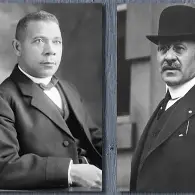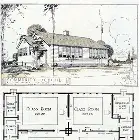In the landscape of American education, few stories are as inspiring—or as overlooked—as the story of the Rosenwald Schools. At a time when access to quality education in the rural South was deeply unequal, businessman and philanthropist Julius Rosenwald partnered with visionary educator Booker T. Washington to create a program that would forever change the future of thousands of African American children. Their efforts built nearly 5,000 schools across the South, many of them in isolated, rural communities where educational opportunity had been intentionally denied for generations.
Today, as conversations about equity, access, and community-driven development continue across the nation, the Rosenwald legacy stands as a powerful example of what can be achieved when philanthropy, community commitment, and a dedication to justice come together.
This blog explores the profound importance of Rosenwald’s contributions, why these schools mattered then, why they matter now, and what their story teaches us about equity in rural education today.
The Educational Crisis in the Rural South
In the early 20th century, the rural South was defined by widespread poverty, racial segregation, and limited access to basic services. For African American families—many of whom were farmers or sharecroppers—public schooling was underfunded, under-resourced, and often nonexistent. Schools for Black children typically lacked books, desks, trained teachers, and even safe buildings.
In many counties, per-student spending for Black children was only a fraction of what was spent on white children. In some rural areas, there were no schools for Black students at all.
The Vision of Booker T. Washington and Julius Rosenwald
The story of the Rosenwald Schools begins with an extraordinary partnership. Booker T. Washington, founder of Tuskegee Institute and one of the most influential Black educators of his time, believed deeply in the transformative power of education, especially for rural African American communities. He also understood the importance of collaboration, planning, and local investment.
A Meeting That Changed History
When Washington met Julius Rosenwald—then the president of Sears, Roebuck & Co.—he found a philanthropist who believed in practical giving, sustainable models, and the principle of “teaching a man to fish.” Rosenwald had long admired Washington’s leadership, and after visiting Tuskegee, he was moved by the need he witnessed in surrounding Alabama communities.
Together, they created a funding model that was revolutionary.
Why Rural Inequality Was So Deeply Rooted
Jim Crow policies created explicit racial barriers to public education. Agrarian poverty meant many families could not pay taxes or local boosters for education. Geographic isolation made school construction difficult and costly, Local governments refused to invest in schools for Black children.
This was the educational environment into which Julius Rosenwald stepped—not with judgment or charity, but with practicality, partnership, and respect.

The Vision of Booker T. Washington and Julius Rosenwald
The story of the Rosenwald Schools begins with an extraordinary partnership. Booker T. Washington, founder of Tuskegee Institute and one of the most influential Black educators of his time, believed deeply in the transformative power of education, especially for rural African American communities. He also understood the importance of collaboration, planning, and local investment.
The Rosenwald School Fund: A Model of Cooperative Philanthropy
Rather than simply donating money and building schools himself, Rosenwald insisted on a partnership approach. Communities that applied for grants had to raise funds locally—through donations, labor, materials, and volunteerism. Local governments also had to contribute.
How the Rosenwald Model Worked
Rosenwald provided seed money, but not full construction funding. Black communities contributed cash, materials, and labor. Local school boards had to contribute funding and agree to operate the school. Schools were built using architectural plans that maximized natural light and ventilation.
This approach ensured that:
- Communities had ownership.
- Schools were integrated into public systems.
- Local governments could not ignore their responsibilities.
The Impact Was Staggering
Between 1912 and 1932:
- 4,977 Rosenwald Schools, teacher homes, and shop buildings were constructed.
- Over 600,000 African American children received an education they otherwise would not have had.
- Many future civil rights leaders were educated in Rosenwald Schools.
It was one of the most significant educational investments in U.S. history.
Why Rosenwald Schools Were So Important for Rural Communities
While Rosenwald Schools existed in many regions, their most profound impact was in deeply isolated rural areas where children had previously been denied basic educational opportunity.
1. They Provided Safe, High-Quality Learning Environments
Rosenwald Schools introduced:
- Well-lit, standardized buildings
- Proper ventilation and sanitation
- Desks, chalkboards, and libraries
These improvements dramatically changed students’ daily experiences.
2. They Created Stable Employment for Black Teachers
Rosenwald Schools became major sources of professional opportunity in rural Black communities. Teachers often became community leaders, mentors, and organizers.
3. They Served as Community Centers
Most rural communities lacked civic spaces. These schools became centers for:
- Adult education
- Social gatherings
- Agricultural workshops
- Civic organizing
- Cultural events
The schoolhouse was the heartbeat of rural Black life.
4. They Improved Economic Mobility
Education changed futures. Rosenwald students went on to:
- Pursue higher education
- Become teachers and professionals
- Enter civic leadership
- Fuel regional civil rights movements
Literacy and learning were paths out of poverty.
The Ripple Effects: How Rosenwald Schools Shaped the Civil Rights Movement
Rosenwald Schools did more than provide an education—they created generations of empowered citizens. The movement for equal rights was fueled by individuals educated in these very classrooms.
Rosenwald alumni became:
- Freedom Riders
- NAACP organizers
- Voter registration volunteers
- Principals and educators
- Leaders in landmark court cases
One historian remarked that without Rosenwald Schools, the Civil Rights Movement would have had “a smaller, quieter army.”
Why the Rosenwald Legacy Still Matters Today
Despite their enormous impact, many Rosenwald Schools disappeared after desegregation. Recently, however, a renewed national effort has brought attention to their importance.
1. They Offer a Guide for Rural Education Reform
Rosenwald’s approach provides lessons for addressing:
- Teacher shortages
- Rural underfunding
- Infrastructure challenges
- Community disengagement
The cooperative model remains relevant.
2. They Represent Resilience and Community Strength
Rosenwald Schools demonstrate:
- How marginalized communities built their own institutions
- How collective action changes lives
- How education fosters dignity and opportunity
They are monuments to perseverance.
3. They Reflect Ethical, Community-Based Philanthropy
Rosenwald believed in:
- Practical solutions
- Shared responsibility
- Spending foundation resources, not hoarding them
- Supporting local leadership
His philosophy is studied in philanthropic circles today.
4. They Deserve Preservation as National Treasures
Only a fraction of the original schools remain standing. Preserving and marking them ensures future generations understand:
- The struggle for educational equity
- The central role of Black communities in rural education
- The origins of modern civil rights movements
These buildings are part of America’s educational and cultural DNA.
The Rosenwald Story Is Still Being Written
From restorations to historical markers, from documentaries to museum exhibits, communities across the nation are re-illuminating the Rosenwald legacy. Places once built with pennies, hope, and sweat are now being recognized for the national treasures they are.
Conclusion: A Legacy of Opportunity, Partnership, and Hope
Julius Rosenwald did not seek fame—he sought solutions. He saw an urgent need and partnered with those most affected to address it. The result was one of the greatest educational achievements in American history.
Rosenwald Schools:
- Transformed rural education
- Uplifted generations of African American families
- Strengthened the foundation of the Civil Rights Movement
- Demonstrated the power of partnership
- Created a blueprint for equitable education
Their story is not simply history—it is a lesson for today.



